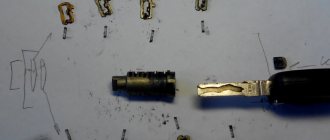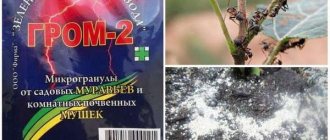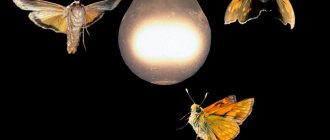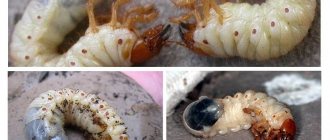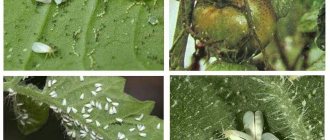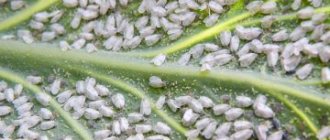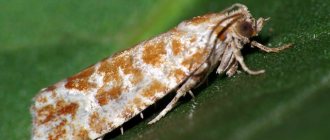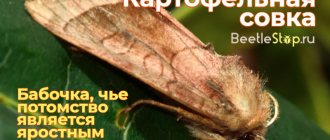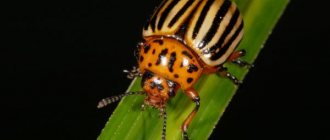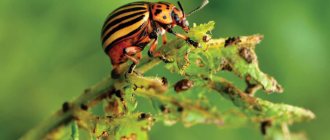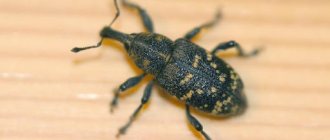Do underground pests in the garden gnaw on potatoes, carrots, beets, radishes, depriving you of hope for a harvest? We will tell you which insects are destroying your root crops and how to deal with pests on your site using a variety of methods.
The ones that most seriously damage underground plantings are mole crickets, wireworms (larvae of the click beetle), beetles (larvae of the May beetle), carrot flies and root-knot nematodes. Together, these creatures are capable of causing irreparable damage to the vegetable garden and flower garden. How to understand that they have settled in your dacha and, most importantly, how to get rid of such a dubious neighborhood?
Types of insects in the soil
Various pests live on the soil surface or at shallow depths:
- herbivorous mites;
- nematodes;
- soil insects (mole crickets, leaf beetles, etc.).
Some types of insect pests lay eggs in the ground, and their larvae (caterpillars), emerging from eggs, destroy the root system, tubers, and root crops.
This group includes:
- darkling beetles;
- weevils;
- May beetles (Khrushchi);
- Lepidoptera (moths and butterflies);
- nutcrackers.
Plant protection from pests and diseases
High-quality pre-sowing work allows you to avoid many problems and difficulties in the summer. The following measures help prevent attacks by insects and animals, as well as diseases spread by parasites:
- Biological. These include the use against pests and pathogens of their natural enemies, i.e. predatory insects, birds, and also use bacteria, fungi and viruses that cause the death of pests.
- Agrotechnical. This category includes special soil treatment, compliance with planting and harvesting dates, proper use of fertilizers, and timely weeding of beds with plants.
- Chemical. They combine seed treatment with fungicides and the use of rodenticides to prevent the invasion of moles and mice.
Cultivated plants are very vulnerable to pest attacks. Competent, timely measures help protect plantings from dangerous insects and animals. All gardeners and gardeners are recommended to study in detail methods of resisting parasites, allowing them to keep their plants healthy and get a generous harvest.
Why is mole cricket dangerous and how to get rid of it?
The mole cricket is a large (5-6 cm) pest of garden plants, whose scientific name means “mole cricket”. The insect's forelimbs are modified like a mole's paws; with them, the mole cricket digs a system of tunnels and passages in the ground. It is very difficult to see insects, since they are nocturnal exclusively underground. The presence of a mole cricket in the garden is indicated by mounds of dug up earth with a round hole in the middle.
Medvedka
Adults and larvae eat succulent, nutritious underground parts of plants:
- root system;
- tubers;
- roots.
Mole cricket larvae are similar to adult insects, only smaller in size, and their diet is the same. Several hundred larvae can emerge from one clutch. In temperate and northern climates, they develop for several years (3-5), causing significant damage to garden plants.
One of the effective ways to combat mole crickets is to loosen the soil in May-June, when reproduction occurs. During digging, fresh masonry is discovered and destroyed.
Before planting, insecticide bait is added to the holes. Effective against mole crickets:
- "Thunder";
- "Grizzly";
- "Phenaxin plus";
- "Beargon."
Traditional methods are also used:
- laying eggs are poured with boiling water;
- spill the soil with a soap solution (200 g of soap per bucket of water);
- watering with infusion of onion peels;
- they set up traps - a bottle with a narrow neck and a wide bottom, for example, champagne, dug in at an angle, filled with fermenting liquid. Insects crawl in and die because they cannot get out.
Other types of pests
Some polyphagous and soil parasites are found in gardens and orchards. The first type of pest is distinguished by its ability to eat everything indiscriminately, without switching between plant species.
Soil parasites live underground. These harmful creatures prefer root vegetables.
Polyphagous
Such pests include:
- Meadow moth.
- Field mice.
meadow moth
The meadow moth ("blizzard") is a small butterfly with grayish-brown wings with two yellowish spots. Harm to cultivated plants is caused by the caterpillars of this insect. They gnaw holes in the leaves, “skeletonizing” them, eat the leaf blade down to the petiole, and can eat the stems. Plants such as sugar beets, corn, and sunflowers suffer the most from pests. Caterpillars love vegetables and potato seedlings.
Entomophages and Trichogramma help reduce the number of insects. Among biological preparations, Bitoxibacillin and Lepidocid are used. When the parasite spreads significantly (more than 5 pests per square meter), insecticides are used.
Field mice
These small rodents with a red-brown back and white belly live in fields, vegetable gardens, and orchards. Such pests are very prolific, create numerous nests and can quickly infest agricultural land.
Field mice chew on everything they come across on their way. This is due to the need for constant growth of teeth and the need to grind them down. In addition to harming beneficial plants, rodents carry dangerous diseases (hemorrhagic fever, tularemia, leptospirosis, erysipelas). The pests themselves may not get sick.
Suitable for mouse control:
- physical methods (mousetraps, traps, repellers);
- chemicals (poisons, aerosols);
- traditional methods (essential oils, building mixtures).
To avoid the appearance of the pest on the site, it is recommended to periodically loosen the soil, keep the area clean, and prevent the accumulation of garbage. An infusion of red elderberry (100 g per 1 liter) is good at repelling animals.
Soil
The soil type of pests is represented by parasites such as khrushchev, shrew, and mole rat.
Khrushchev
This pest is the larva of the cockchafer. Its food includes the roots of trees and shrubs, root vegetables (carrots, beets, radishes). The larva completely or partially eats the underground part of the plant, making it weak and defenseless against viral and fungal infections.
Entomophages (magpies, starlings, rooks, hedgehogs) help get rid of the parasite. Of the synthetic products, the drug Vallara, intended for application to the soil, is effective.
Shrew
A small animal with a long trunk digs numerous underground passages in the area and harms useful plants. When the shrew is active, the root system of the plantings is seriously damaged and the yield is reduced significantly.
Folk methods of expelling the pest from an area where there are useful plants are filling its holes with water, using strong-smelling substances (naphthalene, kerosene, gasoline). Of the chemicals intended to combat rodents, Rat Death, Nutcracker, and Hunter Anti-Rodent work well.
Common mole rat
This underground animal can be quite large (up to 35 cm in length). The mole rat loves to eat root vegetables (carrots, potatoes, beets). The parasite is especially attracted to well-kept, neat beds. Mole rats live in burrows located at a depth of up to 3 m.
It is quite problematic to drive away a pest that has chosen a certain area. Measures to combat the annoying animal - traps, traps, poisons, ultrasonic repellers.
In many cases, an ordinary cat helps to cope with mole rats. To protect the plants, they also resort to flooding the burrows with large volumes of water.
The water method of pest control is ineffective if the soil is sandy or very loose.
The danger of wireworms (larvae of the click beetle), control and prevention measures
Adult black click beetles are common phytophagous pests. Their larvae are long (1.5-3.5 cm) and thin (0.2 cm), having a yellowish color and a metallic sheen - they are called wireworms. The larvae live in the ground and prefer:
- root system of cereals;
- tubers and root vegetables: potatoes, beets, root parsley, parsnips;
- flower bulbs;
- corn;
- sunflower.
Wireworm
Capable of completely destroying sown seeds, the root system of young seedlings, and seedlings. Beetle larvae live in the garden for up to 3-4 years.
Fighting methods:
- before planting, the insecticide Bazudin (analogues of Pochin, Zemlin, Kapkan) mixed with sand or sawdust is added to the holes;
- potato bait: stick a stick into a small piece and lower it into the ground. Periodically, the trap is taken out, the wireworms are destroyed, and the bait is replaced with fresh bait.
As preventive measures:
- compliance with crop rotation;
- planting green manure legumes to saturate the soil with nitrogen;
- weeding, especially carefully it is necessary to destroy wheatgrass - a grass on the roots of which there are often accumulations of wireworms;
- cleaning the area at the end of the season from tops, leaves, etc.
carrot fly
Main harm
The favorite “dishes” of the carrot fly are celery, root parsley, and dill. Damaged plants cannot be stored and deteriorate.
Carrot fly (Photo from wikimedia)
How to prevent the appearance?
- Plant seeds that are resistant to this pest.
- Make beds in sunny areas.
- Do not leave picked plants between the beds.
- Plant marigolds nearby.
- Do not fertilize with fresh manure.
Fighting methods
- Sprinkle tobacco and onion peels between rows.
- Spray the plants with a soap solution or a decoction of tomato tops.
- Use medications (“Vantex”, “Borey”, “Karate Zeon”, “Tsipi”, “Arrivo”).
How to deal with the larvae of the May beetle (Khrushchev) and preventive measures
Adult chafers are not harmful garden pests. Their larvae are especially dangerous - large, thick, white, which live in the soil at a depth of 10-25 cm for 3-4 years. One pest larva is capable of completely gnawing the root system of a two-year-old seedling in 2 days.
May beetle larvae
The female lays eggs in loose soil, and the larvae grow there. To prevent this:
- dig up the area at the end of the season to find beetle larvae preparing for winter;
- mulch the soil in spring and summer (bark, sawdust, chopped straw);
- plant plants that enrich the soil with nitrogen, white clover is best;
- attract natural enemies of larvae to the site - insectivorous birds (jays, orioles, magpies, starlings, blackbirds);
- Before planting in the ground, treat the root system with a solution of a Vallar-type preparation to protect it from being eaten by larvae.
Chemicals against pests*
| Pest | List of drugs | Mode of application |
| Wireworm | Pochin, Zemlin, Vallar, Terradox, Provotox, Biotlin, Bison, Imidor, Iskra, Kalash, Klubneshield, Commander, Corado, Prestige, Prestigator, Respect, Tanrek | Application to the soil before planting |
| Khrushchev | Vallar, Terradox | Dipping the roots of seedlings (seedlings) into insecticidal soil mash before planting and re-applying the drug after 25–30 days to the surface of the earth with embedding to a depth of 5–10 cm. |
Select from the list
Why is carrot fly dangerous, methods of control and preventive measures
The carrot fly is a small (0.5 cm) insect whose larvae live in the soil in the garden. During the season, the fly lays several hundred eggs in 2-3 batches, preferring moist, shaded areas. Larvae, similar to worms (up to 1 cm in length), bore tunnels in root crops, making them bitter and unsuitable for storage.
It is difficult to combat garden pests; for this, potent insecticides are used:
- Arrivo;
- Boreas;
- Vantex.
carrot fly
For planting, it is worth choosing varieties that are resistant to this pest. Also as preventative measures:
- For carrots, you should choose dry, sunlit areas;
- plant onions, garlic, and marigolds between rows to repel pests;
- Remove weeded and thinned carrot seedlings from the area so as not to attract flies with the smell.
Methods for studying soil insects
As V.V. emphasized Dokuchaev, soil is the day or outer horizon of the earth’s crust, formed as a result of the complex interaction of the local climate, plant and animal organisms, and the composition and structure of parent rocks. According to Dokuchaev, it is a natural historical body created by the joint influence of water, air and organisms on the rock. As you can see, the activity of soil fauna (together with plants) is one of the serious factors in the soil-forming process. Therefore, in a comprehensive assessment of soil formation occurring in a particular area, it is necessary to study a complex of animals, the overwhelming majority of which are insects.
The life of 80% of insect species at one time or another is associated with soil (Gilyarov, 1949). The soil provides insects with an optimal microclimate, food, shelter from enemies, and favorable overwintering conditions.
Since methods for studying soil animals vary depending on their size, soil animals are divided according to size into the following groups:
a) nannofauna - animals completely indistinguishable to the naked eye (protozoa, rotifers, nematode larvae, small species of nematodes, larvae of some small mites, etc.);
b) microfauna - animals ranging in size from the limits of visibility to several millimeters in length (many mites, small enchytraeids, springtails, larvae of small dipterans, etc.);
c) mesofauna - ranging in size from several millimeters to several centimeters (earthworms, large enchytraeids, woodlice, millipedes, many insects, large arachnids, slugs, snails).
d) macrofauna - soil-dwelling vertebrates (toads, lizards, snakes, rodents, moles, etc.).
For each of these groups, its own methodology for studying them has been developed.
Based on the degree of connection with the soil, soil-dwelling insects are divided into the following groups:
a) geobionts – insects whose entire life is spent in the soil;
b) geophiles - insects, part of their life cycle necessarily occurs in the soil;
c) geoxenes - insects that more or less accidentally enter the soil, using the soil as a temporary shelter or shelter.
The most general division of soil insects according to the types of food (trophic) connections is as follows:
a) phytophages - insects that feed on the underground parts of living higher plants;
b) zoophages - insects that feed on animal food (predators and parasites);
c) necrophages - feeding on animal corpses;
d) saprophages - feeding on the decaying remains of organisms, mainly plants;
e) mixophages - insects that have a mixed animal-plant diet.
The overwhelming majority of soil insect fauna are relatively large forms belonging to the mesofauna group. Therefore, methods for studying large soil insects are of interest to us.
Soil mesofauna is studied using a variety of methods. The most common among them are the method of soil excavation, the method of sifting litter and soil, the method of trapping grooves and trapping cylinders for the inhabitants of the soil surface and plant litter.
Sifting the substrate on sieves
Recommended for collecting insects from forest litter, moss, heavily decomposed wood, dry manure, river sediment, plant debris, mushrooms, etc. It is convenient to use columns of soil sieves with round (rather than slit-like) holes. It is not rational to use a full column; 3-4 sieves with a diameter of 0.5 mm, 2 mm, 5 mm for the bottom and roof are sufficient.
For collection and recording, samples are taken as follows: measure 1 or 2 sq.m. litter, separate the border and remove all loose substrate covering the soil surface (litter, mosses, sediment, etc.). The substrate is immediately placed in dense bags (calico, polyethylene, etc.). The sample will be stored until processing.
The sample is raked into the upper sieve (clumps of moss, clods, etc. need to be dissected on the sieve, and stones, sticks and other large objects removed). The column is shaken vigorously several times in the vertical and horizontal plane, after which the upper sieve is emptied and refilled with substrate. This operation is repeated several times (when working with loose substrates, care must be taken to ensure that the middle sieves do not overfill by more than a third of their volume), after which the column is sequentially disassembled, removing insects with soft tweezers.
This method allows you to significantly save time and does not require constant intense attention, which gives more stable accounting results (Tikhomirova, 1975.) When working with sieves, you need to keep them dry, protect them from rain, do not sift too wet substrates and make sure that their holes do not clogged. The results are entered into the table - H3.
Table H3 - Substrate analysis result
| No. sample and date | Description of the trial area | Name of insects | Quantity | ||||
| egg | larva | doll | imago | ||||
| 1 | 2 | 3 | 4 | 5 | 6 | 7 | 8 |
The danger of root-knot nematode: how to fight and preventive measures
Microscopic roundworms living in the soil in the garden cause a disease called meloidogynosis. At the same time, galls are formed on the roots - swellings that prevent normal plant nutrition. Through damage, infection occurs with fungal, viral, and parasitic diseases. Productivity is reduced several times.
Biological products have proven themselves to be excellent in the fight against nematodes in the garden:
- Fitoverm;
- Metarizin;
- Aversectin S;
- Nematophagin BT.
Prevention:
- Before planting, the soil and root system of seedlings are disinfected with hot water.
- Weeding and thinning are carried out.
- Removal and burning of affected plants is necessary.
- It is recommended to plant natural phytoncides between rows.
- It would not be superfluous to plant green manure plants in the soil.
Root nematode
Main harm
They settle on the roots of plants and form growths (galls) on them. These new growths interfere with normal metabolism in the plant, and it dies. Potatoes are most often affected.
Galls on leaves (Photo from biathlonmordovia.ru)
How to prevent the appearance?
- Maintain crop rotation.
- Plant nematode-resistant varieties.
- Treat the seed with water 50–55°.
- Water the area with water 50–55°. Cover with cling film to cool.
- Don't plant too thickly.
- Plant marigolds between the beds.
- Completely clear the area of plucked plants and do not leave last year’s crop residues.
Fighting methods
- Biological products. Created on the basis of an extract from marigolds, garlic or calendula, or on the basis of dangerous mushrooms (Arthrobotris, Paecilomyces).
- Poisons based on (nemagon, carbatoin, methyl bromide). Follow the instructions provided.
- Complex products (containing chlorpectin), they are very dangerous and kill all living things in the soil. Such beds should not be used throughout the year.
Harm and methods of combating flea beetles, including preventive measures
Small (up to 4 mm) shiny leaf beetles with strong legs capable of high jumps prefer plants from the cruciferous family:
- cabbage;
- radish;
- turnip;
- daikon;
- radish.
And also flowers:
- gillyflowers;
- Iberis;
- lacfiol;
- fuchsia
Earth flea
The female lays eggs in the top layer of soil 3 times during the summer. The larvae live underground, feeding on roots. Adult beetles eat the upper parts of the leaves.
A proven folk method of control is dusting with wood ash, which can be mixed with tobacco powder (crumbs) in a 1:1 ratio. The procedure is repeated once a week.
Chemicals:
- Aktelik;
- Decis;
- Bankol.
For prevention:
- seedlings should be covered with non-woven material;
- plant repellent plants (dill, marigolds, garlic);
- prevent the appearance of cruciferous weeds (shepherd's purse, rapeseed) on the site, where pests multiply;
- Carry out abundant watering, preferably by sprinkling, to repel fleas that prefer to settle in damp soil;
- practice loosening the soil.
Medvedka
One of the largest garden insect pests that live underground are mole crickets. They have a large body (up to 6 cm long) of a dark brown color, equipped with digging front legs. Capable of cutting all underground parts of garden crops, including potato tubers and tree roots.
On a note!
Such brown beetles prefer to settle in the country on moist soils well fertilized with humus.
Over the years, gardeners have developed several methods to combat mole crickets, which include: deep tillage of the soil (at least 15 cm in spring and autumn), construction of trap pits (diameter 30 cm, depth up to 79 cm) with manure, planting plants in cups, and also biological (Metarizin) and chemical agents.
Mole cricket and snow beetle
How to deal with fall armyworm and the damage it causes
Large gray butterflies, garden pests, fly at night. During the season, the female is capable of laying up to 2 thousand eggs on the lower part of the leaves. Large, glossy caterpillars live in the top layer of soil and have a coloring that allows them to remain undetected. For plants, damage by the cutworm caterpillar is detrimental - it can cut the stem at ground level and eats leaves and seeds, especially sprouted ones.
Effective control measures:
- deep digging of the soil at the end of the season will destroy caterpillars preparing for winter;
- Traps are suitable for catching adult insects: hang cans of fermenting drink (kvass, beer, honey solution) on trees. The butterflies fall into the jar and die.
Fall armyworm
Insecticides against caterpillars:
- Arrivo;
- Sherpa;
- Decis;
- Bazudin.
Snow Beetle
One of the common pests is the large black beetle in the garden or strigun (kravchik). It is colored black, has a body size of several centimeters, lives in underground burrows and has a hard shell, which is why even birds cannot eat it.
On a note!
Black earthen beetles usually appear in early spring, cutting off the first shoots of weeds. After the seedlings appear in the garden, pests are taken for them. Striguns are able to quickly destroy all planted seedlings of garden crops, not even disdaining garlic and onions.
To combat the earthen beetle, gardeners use various traditional methods, ranging from manual collection to digging trenches and installing metal profile sheets around the perimeter of the garden.
Usually, at the beginning of June, these long black beetles already finish their destructive activities, burrowing deep underground and laying eggs to provide themselves with offspring. Therefore, only deep digging of the earth in the fall can help destroy pests, during which the larvae that fall to the surface freeze and die.
Other ground insect pests
Many pests can live on a personal plot:
- in onions - thrips and underground mites;
- in potato tubers - golden nematode, potato flea beetle;
- cucumber roots are parasitized by cucumber mosquito larvae;
- cabbage fly larvae living in the ground infect the roots of the plant and cause death;
- onion moth lays eggs in the soil next to the plant, the caterpillars penetrate the onion stem and feed on it;
- polyphagous snails damage above-ground and underground parts of peppers, cauliflower and white cabbage.

